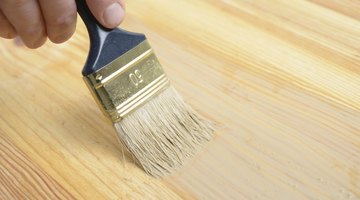How to Strengthen Wood
Before wood makes it to the lumberyard, it's part of a living organism, and its cellular structure is designed to transport nutrients. Consequently, fresh wood is full of water, and using it for a project before it's dry is asking for trouble.

Proper drying stabilizes the cell structure and strengthens wood, but after time, the cell structure eventually deteriorates and crumbles. To reinforce wood in this condition, you need the help of chemicals.
Seasoning Wood
Freshly cut wood isn't a suitable material for any woodworking project. If you don't dry it properly, it will crack and warp, ruining whatever piece you make with it. Most wood you buy in the lumberyard is dry, but not all of it -- especially if it's stacked outdoors. If you use wood from an outdoor pile -- or you mill your own -- you should stabilize it first by stacking it in a dry place for several months. Seal the end-grain with wax to prevent splitting, and put stickers -- small pices of wood -- between layers of boards to facilitate airflow. It's helpful to weight the top of a stack of wood to prevent the boards from bowing as they dry.
Wood Hardener
Old wood loses its strength as the fibers disintegrate -- a condition familiarly known as rot. Before the wood actually crumbles, it turns spongy, and you can still salvage it when it's in this condition by using a wood hardener. Most wood hardeners consist of resin suspended in a volatile solvent. When you paint the hardener on the wood with a brush, the solvent carries the resin deep into the grain and evaporates, leaving the surface of the wood looking natural. You can increase the gloss on the surface by adding more wood hardener or by applying a clear film coating, such as polyurethane or varnish.
Wood Filler
Once rotted wood has actually crumbled, your options for strengthening it are limited to scraping out the rotted wood and filling the cavity. You'll find several brands of two-part epoxy or polyester wood fillers at the store that are suitable for this purpose, and all of them set harder than the wood you're repairing. To make a successful repair, you need to scrape out all the rotted wood diligently so that the filler can bond to intact fibers. Two-part fillers are stiff enough to mold, so you can use them to repair disintegrated edges as well as fill rotted cavities.
Rot Repair Systems
Some manufacturers offer kits for repairing rotted wood that consist of brushable wood hardener, two-part epoxy filler and a syringe. The syringe allows you to inject the filler deep into the grain to fill voids. You can tell that such a void exists when the surface of the wood is spongy even though the surface grain is intact. Injecting filler is an ideal solution for many situations; the syringe allows you to easily repair a rotted spot in a wood floor or deck, or to fill a dry-rotted cavity in a wall stud after repairing the condition that caused the dry rot.
The Drip Cap
- Before wood makes it to the lumberyard, it's part of a living organism, and its cellular structure is designed to transport nutrients.
- Consequently, fresh wood is full of water, and using it for a project before it's dry is asking for trouble.
- Most wood hardeners consist of resin suspended in a volatile solvent.
- To make a successful repair, you need to scrape out all the rotted wood diligently so that the filler can bond to intact fibers.
- Injecting filler is an ideal solution for many situations; the syringe allows you to easily repair a rotted spot in a wood floor or deck, or to fill a dry-rotted cavity in a wall stud after repairing the condition that caused the dry rot.
References
Writer Bio
Chris Deziel has a bachelor's degree in physics and a master's degree in humanities. Besides having an abiding interest in popular science, Deziel has been active in the building and home design trades since 1975. As a landscape builder, he helped establish two gardening companies.
Photo Credits
- -lvinst-/iStock/Getty Images
- -lvinst-/iStock/Getty Images
More Articles


